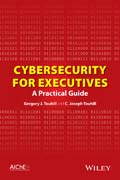
Cybersecurity for Executives: A Practical Guide
Touhill, Gregory J.
Touhill, C. Joseph
Practical guide that can be used by executives to make well–informed decisions on cybersecurity issues to better protect their business • Emphasizes, in a direct and uncomplicated way, how executives can identify, understand, assess, and mitigate risks associated with cybersecurity issues • Covers ‘What to Do When You Get Hacked?’ including Business Continuity and Disaster Recovery planning, Public Relations, Legal and Regulatory issues, and Notifications and Disclosures • Provides steps for integrating cybersecurity into Strategy; Policy and Guidelines; Change Management and Personnel Management • Identifies cybersecurity best practices that executives can and should use both in the office and at home to protect their vital information INDICE: Preface Foreword Chapter 1. Introduction 1.1 Defining Cybersecurity 1.2 Cybersecurity is a Business Imperative 1.3 Cybersecurity is an Executive–Level Concern 1.4 Questions to Ask 1.5 Views of Others 1.6 Cybersecurity is a Full–Time Activity Chapter 2. Why Be Concerned? 2.1 A Classic Hack 2.2 Who Wants Your Fortune? 2.3 Nation State Threats 2.4 Cybercrime is Big Business 2.5 Chapter Summary Chapter 3. Managing Risk 3.1 Who Owns Risk In Your Business? 3.2 What Are Your Risks? 3.3 Calculating Your Risk 3.4 Communicating Risk 3.5 Organizing for Success 3.6 Chapter Summary Chapter 4. Build Your Strategy 4.1 How Much “Cybersecurity” Do I Need? 4.2 The Mechanics of Building Your Strategy 4.3 Avoiding Strategy Failure 4.4 Ways to Incorporate Cybersecurity into Your Strategy 4.5 Plan For Success 4.6 Chapter Summary Chapter 5. Plan for Success 5.1 Turning Vision Into Reality 5.2 Policies Complement Plans 5.3 Procedures Implement Plans 5.4 Exercise Your Plans 5.5 Legal Compliance Concerns 5.6 Auditing 5.7 Chapter Summary Chapter 6. Change Management 6.1 Why Managing Change is Important 6.2 When to Change? 6.3 What is Impacted by Change? 6.4 Change Management and Internal Controls 6.5 Change Management as a Process 6.6 Best Practices in Change Management 6.7 Chapter Summary Chapter 7. Personnel Management 7.1 Finding the Right Fit 7.2 Creating the Team 7.3 Establishing Performance Standards 7.4 Organizational Considerations 7.5 Training for Success 7.6 Special considerations for critical infrastructure protection 7.7 Chapter Summary Chapter 8. Performance Measures 8.1 Why Measure? 8.2 What to Measure? 8.3 Metrics and the C–Suite 8.4 The Executive Cybersecurity Dashboard 8.5 Chapter Summary Chapter 9. What To Do When You Get Hacked 9.1 Hackers already have you under surveillance 9.2 Things to do before tis too late: preparing for the hack 9.3 What to do when bad things happen: implementing your plan 9.4 Foot Stompers 9.5 Fool Me Once… 9.6 Chapter Summary Chapter 10. Boardroom Interactions Acknowledgements Appendix A – Policies Appendix B – General Rules for Email Etiquette Glossary Bibliography Index
- ISBN: 978-1-118-88814-8
- Editorial: Wiley–Blackwell
- Encuadernacion: Cartoné
- Páginas: 408
- Fecha Publicación: 05/09/2014
- Nº Volúmenes: 1
- Idioma: Inglés
